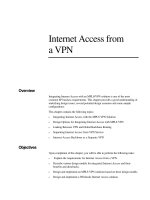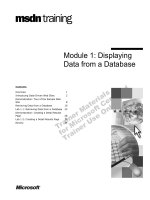Tài liệu Displaying Columns from a Related DataTable doc
Bạn đang xem bản rút gọn của tài liệu. Xem và tải ngay bản đầy đủ của tài liệu tại đây (17.51 KB, 4 trang )
[ Team LiB ]
Recipe 2.17 Displaying Columns from a Related DataTable
Problem
You want to add a column to a DataTable that displays a value from a row in a related
table in the DataSet.
Solution
Use expression columns to retrieve lookup values based on DataRelation objects.
The sample code creates a new DataSet containing the Orders table and the Order Details
table from Northwind. A DataRelation is created between the tables. A column is added
to the Order Details table that gets the CustomerID from the parent Order using the
relation created between the tables. Finally, the default view of the Orders table is bound
to the data grid on the form.
The C# code is shown in Example 2-22
.
Example 2-22. File: LookupColumnsForm.cs
// Namespaces, variables, and constants
using System;
using System.Configuration;
using System.Data;
using System.Data.SqlClient;
// Table name constants
private const String ORDERS_TABLE = "Orders";
private const String ORDERDETAILS_TABLE = "OrderDetails";
// Relation name constants
private const String ORDERS_ORDERDETAILS_RELATION =
"Orders_OrderDetails_Relation";
// Field name constants
private const String ORDERID_FIELD = "OrderID";
private const String CUSTOMERID_FIELD = "CustomerID";
private const String QUANTITY_FIELD = "Quantity";
// . . .
DataSet ds = new DataSet( );
// Fill the Orders table and add it to the DataSet.
SqlDataAdapter da = new SqlDataAdapter("SELECT * FROM Orders",
ConfigurationSettings.AppSettings["Sql_ConnectString"]);
DataTable ordersTable = new DataTable(ORDERS_TABLE);
da.Fill(ordersTable);
ds.Tables.Add(ordersTable);
// Fill the OrderDetails table and add it to the DataSet.
da = new SqlDataAdapter("SELECT * FROM [Order Details]",
ConfigurationSettings.AppSettings["Sql_ConnectString"]);
DataTable orderDetailsTable = new DataTable(ORDERDETAILS_TABLE);
da.Fill(orderDetailsTable);
ds.Tables.Add(orderDetailsTable);
// Create a relation between the tables.
ds.Relations.Add(ORDERS_ORDERDETAILS_RELATION,
ordersTable.Columns[ORDERID_FIELD],
orderDetailsTable.Columns[ORDERID_FIELD],
true);
// Add a column to Orders for the total items in all Order Detail rows.
ordersTable.Columns.Add("TotalQuantity", typeof(int),
"Sum(Child." + QUANTITY_FIELD + ")");
// Add a column to Order Details getting CustomerID from Order parent.
orderDetailsTable.Columns.Add(CUSTOMERID_FIELD, typeof(string),
"Parent(" + ORDERS_ORDERDETAILS_RELATION + ")." +
CUSTOMERID_FIELD);
// Bind the default view of the Order table to the grid.
resultDataGrid.DataSource = ordersTable.DefaultView;
Discussion
An expression column creates a calculated column that displays information from a
related record. You can refer to a column in a parent record by affixing Parent. to the
beginning of the name of the column in the parent table. If there are multiple parent
records because of multiple data relations, the name of the DataRelation is specified
within parentheses and Parent(DataRelationName). is affixed to the name of the column
in the parent table.
The sample code creates a calculated column in the Order Details table retrieving the
CustomerID from the parent Orders record for each Order Details record:
orderDetailsTable.Columns.Add(CUSTOMERID_FIELD, typeof(string),
"Parent(" + ORDERS_ORDERDETAILS_RELATION + ")." +
CUSTOMERID_FIELD);
When the constants are replaced with their values, this code is equivalent to:
orderDetailsTable.Columns.Add("CustomerID", typeof(string),
"Parent(Orders_OrderDetails_Relation).CustomerID");
Similarly, you can refer to child records within an expression by affixing the beginning o
f
the column name in the child table with Child. or Child(DataRelationName). depending
on whether the row has child records from multiple tables. Additionally, since multiple
child records can exist for a parent record, the reference to the child column must be used
within an aggregate function. Supported aggregates are listed in Table 2-15
.
Table 2-15. Aggregate functions supported in DataColumn expressions
Aggregate Description
Avg Average of all values
Count Number of values
Max Largest value
Min Smallest value
StDev Statistical standard deviation of all values
Sum Sum of all values
Var Statistical variance of all values
The sample code creates a calculated column in the Orders table for the total quantity of
all order detail items for an order with the following code:
ordersTable.Columns.Add("TotalQuantity", typeof(int),
"Sum(Child." + QUANTITY_FIELD + ")");
When the constants are replaced with their values, the code is:
ordersTable.Columns.Add("TotalQuantity", typeof(int),
"Sum(Child.Quantity)");
Unlike the sample code referencing a parent row, the DataRelation name is omitted
because only one DataRelation exists and it is unnecessary in this case.
If the parent record has no child records, the aggregate function returns a null reference in
C# or Nothing in VB.NET.
[ Team LiB ]









